Introduction To Programming with Python Lecture 2
Download as pptx, pdf2 likes1,246 views
Slides for Lecture 2 of the course: Introduction to Programming with Python offered at ICCBS. It covers the following topics: Flow Control
1 of 20
Downloaded 39 times


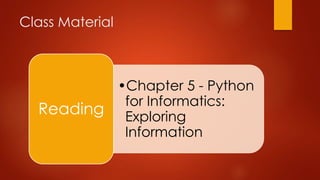

![Conditional Execution
In order to write useful programs, we almost always need to check
some conditions and change the program accordingly. Conditional
Statements gives us this ability. The simplest form is if statement.
General Form:
if [expression1]:
body1
elif [expression2]:
body2
else:
bodyN](https://image.slidesharecdn.com/introductiontoprogrammingwithpython-lecture2-140914153636-phpapp02/85/Introduction-To-Programming-with-Python-Lecture-2-5-320.jpg)

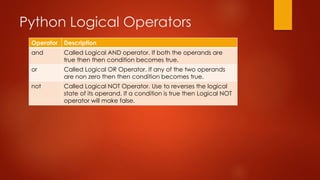

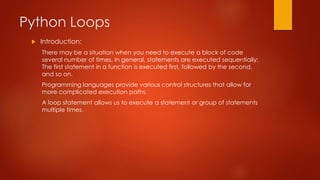
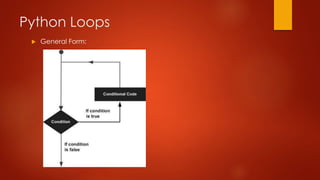
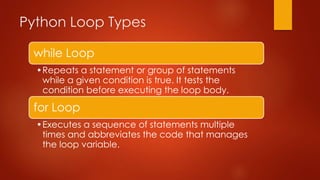
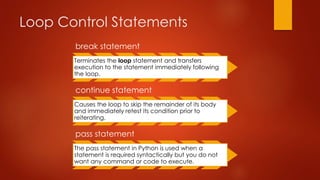
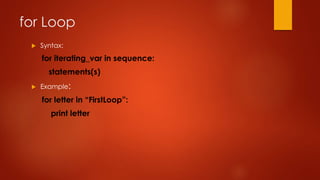
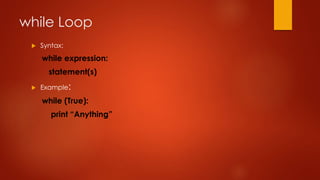


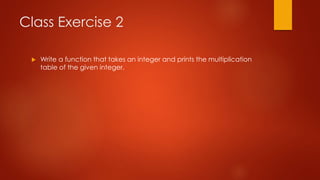



Ad
Recommended
Introduction To Programming with Python-1



Introduction To Programming with Python-1Syed Farjad Zia Zaidi Slides for Lecture 1 of the course: Introduction to Programming with Python offered at ICCBS.
It covers the following topics:
1.) Variables, Statements and Expressions
2.) Functions
3.) Flow Control
Lesson 02 python keywords and identifiers



Lesson 02 python keywords and identifiersNilimesh Halder Introduction to Python Programming Language - Learn by End-to-End Examples.
Week 01 - Python Introduction
WACAMLDS - https://wacamlds.com.au
Control structures functions and modules in python programming



Control structures functions and modules in python programmingSrinivas Narasegouda The document discusses control structures, functions, modules, and Python's standard library. It covers topics like conditional branching, looping, functions, modules, packages, exceptions, strings, and more. Custom functions in Python include global functions, local functions, lambda functions, and methods. Modules allow packaging functionality and importing it into other code.
Introduction to Python 



Introduction to Python Mohammed Sikander This document provides an introduction to the Python programming language. It discusses Python's design philosophy emphasizing readability. It also covers printing messages, reading input, variables and data types, operators, and basic syntax like comments and identifiers. Arithmetic, relational, logical and bitwise operators are explained along with examples.
Lesson 03 python statement, indentation and comments



Lesson 03 python statement, indentation and commentsNilimesh Halder Introduction to Python Programming Language - Learn by End-to-End Examples
Find more at https://setscholars.net
Functions in Python



Functions in PythonShakti Singh Rathore Functions are blocks of reusable code that perform specific tasks. There are three types of functions in Python: built-in functions, anonymous lambda functions, and user-defined functions. Functions help organize code by breaking programs into smaller, modular chunks. They reduce code duplication, decompose complex problems, improve clarity, and allow code reuse. Functions can take arguments and return values. Built-in functions are pre-defined to perform operations and return results when given the required arguments.
Python Fundamentals Class 11



Python Fundamentals Class 11chinthala Vijaya Kumar Python Fundamentals Class 11
This covers the following concepts
1. Python operators
2. Basic structure of python
3. Dynamic typing
4. Input and Output Functions
C language UPTU Unit3 Slides



C language UPTU Unit3 SlidesAnurag University Hyderabad I am working as a Assistant Professor in ITS, Ghaziabad.These 'C' language slides are very useful for students of any university.
Recursion CBSE Class 12



Recursion CBSE Class 12chinthala Vijaya Kumar Recursion is a process where a function calls itself directly or indirectly. It is implemented in Python through recursive functions, where a function calls itself. As an example, a recursive function is provided to calculate the factorial of a number by recursively calling itself and multiplying the number by the factorial of the number below it until reaching the base case of 1. For recursion to terminate, there must be a base case condition specified. The Python interpreter limits recursion depth to 1000 by default to avoid stack overflows from infinite recursion.
Control Structures in Python



Control Structures in PythonSumit Satam Part 2 - Control Structures in Python. To help all learners of Python to understand control structures easily with suitable examples at each step.
Functions in python slide share



Functions in python slide shareDevashish Kumar The document discusses various concepts related to functions in Python including defining functions, passing arguments, default arguments, arbitrary argument lists, lambda expressions, function annotations, and documentation strings. Functions provide modularity and code reusability. Arguments can be passed by value or reference and default values are evaluated once. Keyword, arbitrary and unpacked arguments allow flexible calling. Lambda expressions define small anonymous functions. Annotations provide type metadata and docstrings document functions.
Review Python



Review PythonManishTiwari326 This document provides an overview of the Python programming language. It discusses what a program and programming language are, and then describes key features of Python like being simple, interactive, and object-oriented. It explains how to install Python and work in interactive and script modes. The document also covers Python concepts like variables, data types, functions, operators, and control structures like conditional statements and loops.
Python Functions



Python FunctionsMohammed Sikander Python functions allow for reusable code through defining functions, passing arguments, returning values, and setting scopes. Functions can take positional or keyword arguments, as well as variable length arguments. Default arguments allow functions to specify default values for optional parameters. Functions are objects that can be assigned to variables and referenced later.
Operators used in vb.net



Operators used in vb.netJaya Kumari This document discusses operators in VB.NET. It defines operators as symbols that perform operations on variables or values. It describes different types of operators such as arithmetic, comparison, logical, bitwise, and assignment operators. It provides examples of common operators like addition, subtraction, equality checks and AND/OR logic. The document also covers operator precedence and how it determines the order of operations.
Python Built-in Functions and Use cases



Python Built-in Functions and Use casesSrajan Mor This presentation shows the basic description of the built-in functions in Python along with the use cases of those functions.
Cpu-fundamental of C



Cpu-fundamental of CSuchit Patel This document provides an overview of fundamental concepts in C programming language including header files, character sets, tokens, keywords, identifiers, variables, constants, operators, data types, and control structures. Header files contain predefined standard library functions that are included using directives like #include<stdio.h>. C has 32 reserved keywords that cannot be used as identifiers. Variables are used to store and manipulate data in a program. Constants represent fixed values like integers, characters, and floating-point numbers. Operators perform operations on variables and constants. Data types specify the type and size of a variable. Control structures like if-else and loops are used to control the flow of a program.
Lesson 5 php operators



Lesson 5 php operatorsMLG College of Learning, Inc Operators in PHP are used to perform operations on variables and values. They are divided into arithmetic, assignment, comparison, increment/decrement, logical, string, array, and conditional assignment operators. PHP arithmetic operators perform common math operations, assignment operators write values to variables, and comparison operators compare two values.
The Awesome Python Class Part-2



The Awesome Python Class Part-2Binay Kumar Ray This document discusses setting up a Python environment, writing basic Python code, and introducing fundamental Python data types and data structures. It explains how to install Python and pip, use virtual environments, follow proper code formatting via indentation, and write a simple "Hello World" program. It also overviewed common Python data types like integers, floats, and strings that do not require explicit type definition, as well as mutable and immutable basic data structures including lists, dictionaries, tuples, and sets.
Lambda Expressions in C# From Beginner To Expert - Jaliya Udagedara



Lambda Expressions in C# From Beginner To Expert - Jaliya UdagedaraJaliya Udagedara This document discusses lambda expressions in C#. It introduces lambda expressions as anonymous inline functions that can be used wherever delegates are required. It covers the evolution of delegates from named methods to anonymous methods to lambda expressions. It also discusses how lambda expressions can be used as generic delegates like Action, Func and Predicate. Finally, it discusses how lambda expressions are executed when called, not when constructed, and how they can be used as callbacks by passing a function as a parameter to another function.
Handout # 4 functions + scopes 



Handout # 4 functions + scopes NUST Stuff Overloaded functions allow multiple functions with the same name but different parameter types. This improves readability and handles incorrect arguments. The document provides examples of overloaded averaging and calculator functions. Pass by reference passes a variable's address rather than value, allowing the original variable to be modified. Scope defines variable visibility - variables are destroyed when exiting a scope unless declared static or global. Practice questions demonstrate overloaded functions, pass by reference, scopes, and static/global variables.
Anton Kasyanov, Introduction to Python, Lecture2



Anton Kasyanov, Introduction to Python, Lecture2Anton Kasyanov This document provides an introduction and overview of key concepts in Python, including variables, types, functions, and conditional statements. It discusses how variables store and reference values, Python's dynamic typing, and how functions are defined with the def keyword. Conditionals like if/else statements are explained, with the general form being an if conditional block followed by optional elif and else blocks. Homework involves implementing functions for logical operations, distance calculation, and percent calculation.
Functions in Python



Functions in PythonKamal Acharya This slide contains detail information regarding the types of functions in python and their implementation
Getting started with c++



Getting started with c++K Durga Prasad This document provides an introduction to C++ programming, covering key concepts like characters, tokens, keywords, identifiers, literals, operators, I/O streams, variables, comments, and common errors. It explains that Bjarne Stroustrup extended C to create C++, adding object-oriented features from Simula. The main components discussed are the building blocks of any C++ program - characters, tokens, data types, and basic input/output operations.
Ap Power Point Chpt8



Ap Power Point Chpt8dplunkett Recursion is a fundamental programming technique where a method calls itself to solve a problem. This chapter discusses recursive thinking and programming, providing examples of recursion in sorting, graphics, and solving puzzles like the Towers of Hanoi. Some key algorithms covered are merge sort, quick sort, maze traversal, and generating fractals. Recursive solutions can provide elegant code but require careful structuring to avoid infinite recursion.
Python recursion



Python recursionProf. Dr. K. Adisesha This document discusses recursion in programming. It defines recursion as a technique for solving problems by repeatedly applying the same procedure to reduce the problem into smaller sub-problems. The key aspects of recursion covered include recursive functions, how they work by having a base case and recursively calling itself, examples of recursive functions in Python like calculating factorials and binary search, and the differences between recursion and iteration approaches.
Python functions



Python functionsProf. Dr. K. Adisesha Functions allow programmers to organize code into reusable blocks. A function is defined using the def keyword and can accept parameters. The body of a function contains a set of statements that run when the function is called. Functions can return values and allow code to be reused, reducing errors and improving readability. Parameters allow information to be passed into functions, while return values allow functions to provide results.
The Awesome Python Class Part-3



The Awesome Python Class Part-3Binay Kumar Ray This document provides a summary of previous parts of a Python tutorial and introduces several Python concepts including input, iterators, generators, ranges, operators, and control flow. It discusses how to take input in Python, defines iterators and generators, explains the difference between range and xrange, outlines common arithmetic, comparison, assignment, logical, membership, and identity operators, and covers loops, branches, and order of operations in Python. The document is intended to continue guiding the reader through learning Python.
introduction to python



introduction to pythonSardar Alam This document provides an introduction to Python programming for an artificial intelligence lab course. It covers downloading and installing Python and the Anaconda distribution, using Spyder as an IDE, variables and data types in Python, and basic concepts like indentation, variable naming conventions, and Python keywords. The goal is to prepare students to use Python for labs related to artificial intelligence topics.
Introduction to Python



Introduction to PythonNowell Strite This document provides an introduction and overview of the Python programming language. It covers Python's history and key features such as being object-oriented, dynamically typed, batteries included, and focusing on readability. It also discusses Python's syntax, types, operators, control flow, functions, classes, imports, error handling, documentation tools, and popular frameworks/IDEs. The document is intended to give readers a high-level understanding of Python.
Python lecture 11



Python lecture 11Tanwir Zaman This document provides an overview and outline of lecture 11 of CS 3430: Introduction to Python and Perl at Utah State University. It covers basic network programming concepts like sockets, clients, servers, TCP, UDP and includes code examples for minimal servers and clients. It also discusses handling multiple connections, accessing URLs, opening remote files, getting HTML source, and installing and checking availability of the Python Imaging Library (PIL).
More Related Content
What's hot (19)
Recursion CBSE Class 12



Recursion CBSE Class 12chinthala Vijaya Kumar Recursion is a process where a function calls itself directly or indirectly. It is implemented in Python through recursive functions, where a function calls itself. As an example, a recursive function is provided to calculate the factorial of a number by recursively calling itself and multiplying the number by the factorial of the number below it until reaching the base case of 1. For recursion to terminate, there must be a base case condition specified. The Python interpreter limits recursion depth to 1000 by default to avoid stack overflows from infinite recursion.
Control Structures in Python



Control Structures in PythonSumit Satam Part 2 - Control Structures in Python. To help all learners of Python to understand control structures easily with suitable examples at each step.
Functions in python slide share



Functions in python slide shareDevashish Kumar The document discusses various concepts related to functions in Python including defining functions, passing arguments, default arguments, arbitrary argument lists, lambda expressions, function annotations, and documentation strings. Functions provide modularity and code reusability. Arguments can be passed by value or reference and default values are evaluated once. Keyword, arbitrary and unpacked arguments allow flexible calling. Lambda expressions define small anonymous functions. Annotations provide type metadata and docstrings document functions.
Review Python



Review PythonManishTiwari326 This document provides an overview of the Python programming language. It discusses what a program and programming language are, and then describes key features of Python like being simple, interactive, and object-oriented. It explains how to install Python and work in interactive and script modes. The document also covers Python concepts like variables, data types, functions, operators, and control structures like conditional statements and loops.
Python Functions



Python FunctionsMohammed Sikander Python functions allow for reusable code through defining functions, passing arguments, returning values, and setting scopes. Functions can take positional or keyword arguments, as well as variable length arguments. Default arguments allow functions to specify default values for optional parameters. Functions are objects that can be assigned to variables and referenced later.
Operators used in vb.net



Operators used in vb.netJaya Kumari This document discusses operators in VB.NET. It defines operators as symbols that perform operations on variables or values. It describes different types of operators such as arithmetic, comparison, logical, bitwise, and assignment operators. It provides examples of common operators like addition, subtraction, equality checks and AND/OR logic. The document also covers operator precedence and how it determines the order of operations.
Python Built-in Functions and Use cases



Python Built-in Functions and Use casesSrajan Mor This presentation shows the basic description of the built-in functions in Python along with the use cases of those functions.
Cpu-fundamental of C



Cpu-fundamental of CSuchit Patel This document provides an overview of fundamental concepts in C programming language including header files, character sets, tokens, keywords, identifiers, variables, constants, operators, data types, and control structures. Header files contain predefined standard library functions that are included using directives like #include<stdio.h>. C has 32 reserved keywords that cannot be used as identifiers. Variables are used to store and manipulate data in a program. Constants represent fixed values like integers, characters, and floating-point numbers. Operators perform operations on variables and constants. Data types specify the type and size of a variable. Control structures like if-else and loops are used to control the flow of a program.
Lesson 5 php operators



Lesson 5 php operatorsMLG College of Learning, Inc Operators in PHP are used to perform operations on variables and values. They are divided into arithmetic, assignment, comparison, increment/decrement, logical, string, array, and conditional assignment operators. PHP arithmetic operators perform common math operations, assignment operators write values to variables, and comparison operators compare two values.
The Awesome Python Class Part-2



The Awesome Python Class Part-2Binay Kumar Ray This document discusses setting up a Python environment, writing basic Python code, and introducing fundamental Python data types and data structures. It explains how to install Python and pip, use virtual environments, follow proper code formatting via indentation, and write a simple "Hello World" program. It also overviewed common Python data types like integers, floats, and strings that do not require explicit type definition, as well as mutable and immutable basic data structures including lists, dictionaries, tuples, and sets.
Lambda Expressions in C# From Beginner To Expert - Jaliya Udagedara



Lambda Expressions in C# From Beginner To Expert - Jaliya UdagedaraJaliya Udagedara This document discusses lambda expressions in C#. It introduces lambda expressions as anonymous inline functions that can be used wherever delegates are required. It covers the evolution of delegates from named methods to anonymous methods to lambda expressions. It also discusses how lambda expressions can be used as generic delegates like Action, Func and Predicate. Finally, it discusses how lambda expressions are executed when called, not when constructed, and how they can be used as callbacks by passing a function as a parameter to another function.
Handout # 4 functions + scopes 



Handout # 4 functions + scopes NUST Stuff Overloaded functions allow multiple functions with the same name but different parameter types. This improves readability and handles incorrect arguments. The document provides examples of overloaded averaging and calculator functions. Pass by reference passes a variable's address rather than value, allowing the original variable to be modified. Scope defines variable visibility - variables are destroyed when exiting a scope unless declared static or global. Practice questions demonstrate overloaded functions, pass by reference, scopes, and static/global variables.
Anton Kasyanov, Introduction to Python, Lecture2



Anton Kasyanov, Introduction to Python, Lecture2Anton Kasyanov This document provides an introduction and overview of key concepts in Python, including variables, types, functions, and conditional statements. It discusses how variables store and reference values, Python's dynamic typing, and how functions are defined with the def keyword. Conditionals like if/else statements are explained, with the general form being an if conditional block followed by optional elif and else blocks. Homework involves implementing functions for logical operations, distance calculation, and percent calculation.
Functions in Python



Functions in PythonKamal Acharya This slide contains detail information regarding the types of functions in python and their implementation
Getting started with c++



Getting started with c++K Durga Prasad This document provides an introduction to C++ programming, covering key concepts like characters, tokens, keywords, identifiers, literals, operators, I/O streams, variables, comments, and common errors. It explains that Bjarne Stroustrup extended C to create C++, adding object-oriented features from Simula. The main components discussed are the building blocks of any C++ program - characters, tokens, data types, and basic input/output operations.
Ap Power Point Chpt8



Ap Power Point Chpt8dplunkett Recursion is a fundamental programming technique where a method calls itself to solve a problem. This chapter discusses recursive thinking and programming, providing examples of recursion in sorting, graphics, and solving puzzles like the Towers of Hanoi. Some key algorithms covered are merge sort, quick sort, maze traversal, and generating fractals. Recursive solutions can provide elegant code but require careful structuring to avoid infinite recursion.
Python recursion



Python recursionProf. Dr. K. Adisesha This document discusses recursion in programming. It defines recursion as a technique for solving problems by repeatedly applying the same procedure to reduce the problem into smaller sub-problems. The key aspects of recursion covered include recursive functions, how they work by having a base case and recursively calling itself, examples of recursive functions in Python like calculating factorials and binary search, and the differences between recursion and iteration approaches.
Python functions



Python functionsProf. Dr. K. Adisesha Functions allow programmers to organize code into reusable blocks. A function is defined using the def keyword and can accept parameters. The body of a function contains a set of statements that run when the function is called. Functions can return values and allow code to be reused, reducing errors and improving readability. Parameters allow information to be passed into functions, while return values allow functions to provide results.
The Awesome Python Class Part-3



The Awesome Python Class Part-3Binay Kumar Ray This document provides a summary of previous parts of a Python tutorial and introduces several Python concepts including input, iterators, generators, ranges, operators, and control flow. It discusses how to take input in Python, defines iterators and generators, explains the difference between range and xrange, outlines common arithmetic, comparison, assignment, logical, membership, and identity operators, and covers loops, branches, and order of operations in Python. The document is intended to continue guiding the reader through learning Python.
Viewers also liked (20)
introduction to python



introduction to pythonSardar Alam This document provides an introduction to Python programming for an artificial intelligence lab course. It covers downloading and installing Python and the Anaconda distribution, using Spyder as an IDE, variables and data types in Python, and basic concepts like indentation, variable naming conventions, and Python keywords. The goal is to prepare students to use Python for labs related to artificial intelligence topics.
Introduction to Python



Introduction to PythonNowell Strite This document provides an introduction and overview of the Python programming language. It covers Python's history and key features such as being object-oriented, dynamically typed, batteries included, and focusing on readability. It also discusses Python's syntax, types, operators, control flow, functions, classes, imports, error handling, documentation tools, and popular frameworks/IDEs. The document is intended to give readers a high-level understanding of Python.
Python lecture 11



Python lecture 11Tanwir Zaman This document provides an overview and outline of lecture 11 of CS 3430: Introduction to Python and Perl at Utah State University. It covers basic network programming concepts like sockets, clients, servers, TCP, UDP and includes code examples for minimal servers and clients. It also discusses handling multiple connections, accessing URLs, opening remote files, getting HTML source, and installing and checking availability of the Python Imaging Library (PIL).
Python lecture 8



Python lecture 8Tanwir Zaman This document outlines key concepts in object-oriented programming including constructors, polymorphism, encapsulation, inheritance, and an introduction to Pygame. It discusses how constructors are called to initialize objects, how polymorphism allows the same method to work on different types, and how encapsulation hides unnecessary details from users. Inheritance and multiple inheritance are explained with examples of subclasses inheriting and overriding methods. Finally, installing and initializing Pygame is briefly covered along with an overview of the game loop structure.
Python lecture 02



Python lecture 02Tanwir Zaman This document provides an overview and outline of a lecture on Python & Perl. It discusses editing Python code, running Python programs, sample programs, Python code execution, functional abstraction using Newton's square root approximation, and tuples. Key points covered include how Python uses indentation instead of curly braces, running Python code from the command line on Windows, Linux and Mac, and how tuples are immutable sequences defined with parentheses.
Cs3430 lecture 17



Cs3430 lecture 17Tanwir Zaman This document provides an overview of arrays, references, multi-dimensional arrays, hashes, and sorting in Perl. It discusses array references, constructing and iterating over multi-dimensional arrays, default and customized sorting of arrays, and how to construct, manipulate, and reference hashes in Perl code. Examples are provided to demonstrate these key concepts.
Python lecture 01



Python lecture 01Tanwir Zaman This document provides an overview and outline of a course on Python and Perl programming. The course will cover Python for 10 weeks and Perl for 5 weeks, with exams on each language. Students will complete weekly coding assignments and a final project. The document discusses installing Python on various operating systems, key Python concepts like variables, lists, strings and tuples, and recommends texts for further reading.
Substituting HDF5 tools with Python/H5py scripts



Substituting HDF5 tools with Python/H5py scriptsThe HDF-EOS Tools and Information Center A brief overview of using HDF5 with Python and Andrew Collette's h5py module will be presented, including examples which show how and why Python can be used in the place of HDF5 tools. Extensions to the HDF5 API will be proposed which would further improve the utility of Python/h5py.
Logic Over Language



Logic Over LanguagePurple, Rock, Scissors Understand programming through a pseudo-code example with PRPL Senior Engineer Renee Blunt. Accompanies video found here: https://youtu.be/RHrLGJP7AmI
Python and HDF5: Overview



Python and HDF5: Overviewandrewcollette From a talk by Andrew Collette to the Boulder Earth and Space Science Informatics Group (BESSIG) on November 20, 2013.
This talk explores how researchers can use the scalable, self-describing HDF5 data format together with the Python programming language to improve the analysis pipeline, easily archive and share large datasets, and improve confidence in scientific results. The discussion will focus on real-world applications of HDF5 in experimental physics at two multimillion-dollar research facilities: the Large Plasma Device at UCLA, and the NASA-funded hypervelocity dust accelerator at CU Boulder. This event coincides with the launch of a new O’Reilly book, Python and HDF5: Unlocking Scientific Data.
As scientific datasets grow from gigabytes to terabytes and beyond, the use of standard formats for data storage and communication becomes critical. HDF5, the most recent version of the Hierarchical Data Format originally developed at the National Center for Supercomputing Applications (NCSA), has rapidly emerged as the mechanism of choice for storing and sharing large datasets. At the same time, many researchers who routinely deal with large numerical datasets have been drawn to the Python by its ease of use and rapid development capabilities.
Over the past several years, Python has emerged as a credible alternative to scientific analysis environments like IDL or MATLAB. In addition to stable core packages for handling numerical arrays, analysis, and plotting, the Python ecosystem provides a huge selection of more specialized software, reducing the amount of work necessary to write scientific code while also increasing the quality of results. Python’s excellent support for standard data formats allows scientists to interact seamlessly with colleagues using other platforms.
An Introduction to Interactive Programming in Python 2013



An Introduction to Interactive Programming in Python 2013Syed Farjad Zia Zaidi My Verified Certificate for An Introduction to Interactive Programming in Python 2013 by Rice University and offered through Coursera
Introduction to Databases



Introduction to DatabasesSyed Farjad Zia Zaidi This document is a Stanford Online Statement of Accomplishment certifying that Syed Farjad Zia Zaidi successfully completed with distinction an online Introduction to Databases course offered through OpenEdX. However, it does not confer any Stanford University course credit, grade, or degree and only verifies completion, not the student's identity.
Logic: Language and Information 1



Logic: Language and Information 1Syed Farjad Zia Zaidi My Verified Certificate for Logic: Language and Information 1 by The University of Melbourne and offered through Coursera.
Introduction To Programming with Python-5



Introduction To Programming with Python-5Syed Farjad Zia Zaidi Slides for Lecture 5 of the course: Introduction to Programming with Python offered at ICCBS.
It covers the following topics:
1.)Python Modules
2.)File I/O
3.)Exceptions & Error Handling
Introduction To Programming with Python-4



Introduction To Programming with Python-4Syed Farjad Zia Zaidi This document provides an introduction to using lists in Python. It defines what lists are in Python, how to create, access, update, and delete list elements, and some common list operations. It also provides examples of creating lists, accessing values at different indices, updating and deleting elements, and using basic operators like addition and multiplication. Finally, it proposes three exercises involving lists to practice these concepts.
Introduction to UBI



Introduction to UBIRoy Lee This document describes UBI (Unsorted Block Images), a volume management system for flash devices in Linux. It provides static and dynamic volumes, wear-leveling across the entire flash device, bad block management, and read disturbance handling. The key components of UBI are the kernel API, EBA (Erase Block Association) subsystem, wear-leveling subsystem, and scanning subsystem. The wear-leveling subsystem manages PEBs (Physical Erase Blocks) using RB-trees and a queue to perform wear leveling and scrubbing.
Python 4 Arc



Python 4 Arcabsvis This document provides an overview of using Python and the Geoprocessor object to automate geoprocessing tasks in ArcGIS. It discusses:
1) Converting multiple ASCII files to rasters, merging the rasters, reclassifying the data, and converting it to polygon and polyline shapefiles involves many manual steps.
2) Scripting can automate this repetitive process and save time compared to performing the tasks manually each time.
3) The Geoprocessor object in ArcGIS provides a single access point to the toolbox and its methods/properties can be used to programmatically run geoprocessing tools from Python scripts.
The Python Programming Language and HDF5: H5Py



The Python Programming Language and HDF5: H5PyThe HDF-EOS Tools and Information Center An introduction to the Python programming language and its numerical abilities will be presented. With this background, Andrew Collette's H5Py module--an HDF5-Python interface--will be explained highlighting the unique and useful similarities between Python data structures and HDF5.
Clase 2 estatica 



Clase 2 estatica Gerald Moreira Ramírez La mecánica es la ciencia que estudia el movimiento y reposo de los cuerpos bajo la acción de fuerzas. Se divide en mecánica de cuerpos rígidos, deformables y fluidos. La mecánica de cuerpos rígidos se subdivide en estática, que estudia cuerpos en reposo, y dinámica, que estudia cuerpos en movimiento. La mecánica se remonta a Aristóteles y Newton y utiliza conceptos como fuerza, masa, espacio y tiempo.
Using HDF5 and Python: The H5py module



Using HDF5 and Python: The H5py moduleThe HDF-EOS Tools and Information Center This document discusses using Python with the H5py module to interact with HDF5 files. Some key points made include:
- H5py allows HDF5 files to be manipulated as if they were Python dictionaries, with dataset names as keys and arrays as values.
- NumPy provides array manipulation capabilities to work with the dataset values retrieved from HDF5 files.
- Examples demonstrate reading and writing HDF5 datasets, comparing contents of datasets between files, and recursively listing contents of an HDF5 file.
- Using Python with H5py is more concise than other languages like C/Fortran, reducing development time and potential for errors.
Ad
Similar to Introduction To Programming with Python Lecture 2 (20)
Lecture_11.pdf



Lecture_11.pdfinboxelavarasan The document discusses loops and conditionals in Python. It covers relational operators that compare values and return Booleans, assignment operators, Boolean operators, if/elif/else statements, truth and Boolean tests, while and for loops, nested loops, and multi-dimensional lists. Relational operators allow comparisons, if/elif/else statements create conditional logic flows, and loops allow repeated execution of code. Proper use of these structures allows for flexible control flow in Python programs.
Python Unit 3 - Control Flow and Functions



Python Unit 3 - Control Flow and FunctionsDhivyaSubramaniyam This PDF contains notes about control flow and functions in problem solving and python programming (as per Anna university syllabus)
Python Programming | JNTUK | UNIT 2 | Lecture 6 & 7 | Conditional & Control S...



Python Programming | JNTUK | UNIT 2 | Lecture 6 & 7 | Conditional & Control S...FabMinds The document discusses various Python programming concepts including control statements, loops, strings, files and string manipulation. Control statements like if-else are used to conditionally execute code. Loops like for and while are used to repeatedly execute code while a condition is true. Strings can be manipulated using indexing, slicing and other string methods. Files can be read from and written to using file handling methods in Python.
Slide 6_Control Structures.pdf



Slide 6_Control Structures.pdfNuthalapatiSasidhar Control structures determine the flow of execution of code in a program. There are three main types of control structures: sequential, selection, and iteration. Sequential execution runs code in order. Selection (if/else statements) allows branching based on conditions. Iteration (loops) repeats code. Common loop structures are while, for, and nested loops. Loop control statements like break, continue, and pass alter normal loop execution.
Introduction To Python.pptx



Introduction To Python.pptxAnum Zehra This document provides an introduction and overview of the Python programming language. It describes Python as a general-purpose, object-oriented programming language with features like high-level programming capabilities, an easily understandable syntax, portability, and being easy to learn. It then discusses Python's characteristics like being an interpreted language, supporting object-oriented programming, being interactive and easy to use, having straightforward syntax, being portable, extendable, and scalable. The document also outlines some common uses of Python like for creating web and desktop applications, and provides examples of using Python's interactive and script modes.
“Python” or “CPython” is written in C/C+



“Python” or “CPython” is written in C/C+Mukeshpanigrahy1 This Programming Language Python Tutorial is very well suited for beginners and also for experienced programmers. This specially designed free Python tutorial will help you learn Python programming most efficiently, with all topics from basics to advanced (like Web-scraping, Django, Learning, etc.) with examples.
What is Python?
Python is a high-level, general-purpose, and very popular programming language. Python programming language (latest Python 3) is being used in web development, and Machine Learning applications, along with all cutting-edge technology in Software Industry. Python language is being used by almost all tech-giant companies like – Google, Amazon, Facebook, Instagram, Dropbox, Uber… etc.
Writing your first Python Program to Learn PythonSetting up Python
Download and Install Python 3 Latest Version
How to set up Command Prompt for Python in Windows10
Setup Python VS Code or PyCharm
Creating Python Virtual Environment in Windows and Linux
Note: Python 3.13 is the latest version of Python, but Python 3.12 is the latest stable version.
Now let us deep dive into the basics and components to learn Python Programming:
Getting Started with Python Programming
Welcome to the Python tutorial section! Here, we’ll cover the essential elements you need to kickstart your journey in Python programming. From syntax and keywords to comments, variables, and indentation, we’ll explore the foundational concepts that underpin Python development.
Learn Python Basics
Syntax
Keywords in Python
Comments in Python
Learn Python Variables
Learn Python Data Types
Indentation and why is it important in Python
Learn Python Input/Output
In this segment, we delve into the fundamental aspects of handling input and output operations in Python, crucial for interacting with users and processing data effectively. From mastering the versatile print() function to exploring advanced formatting techniques and efficient methods for receiving user input, this section equips you with the necessary skills to harness Python’s power in handling data streams seamlessly.
Python print() function
python.pptx



python.pptxPoornima116356 A Structured programming is an important feature of a programming language which comprises following logical structure
python operators.ppt



python operators.pptErnieAcuna The document discusses various operators and control flow statements in Python. It covers arithmetic, comparison, logical, assignment and membership operators. It also covers if-else conditional statements, while and for loops, and break, continue and pass statements used with loops. The key points are:
- Python supports operators like +, -, *, / etc. for arithmetic and ==, !=, >, < etc. for comparison.
- Control flow statements include if-else for conditional execution, while and for loops for repetition, and break/continue to control loop flow.
- The while loop repeats as long as the condition is true. for loops iterate over sequences like lists, tuples using a loop variable.
Python Control structures



Python Control structuresSiddique Ibrahim This PPT shows the complete reference of python control flow.it covers python if, if else,for,while,elif
UNIT - 2 : 20ACS04 – PROBLEM SOLVING AND PROGRAMMING USING PYTHON



UNIT - 2 : 20ACS04 – PROBLEM SOLVING AND PROGRAMMING USING PYTHONNandakumar P UNIT-II CONTROL STRUCTURES& COLLECTIONS
Control Structures: Boolean expressions, Selection control and Iterative control. Arrays - Creation, Behavior of Arrays, Operations on Arrays, Built-In Methods of Arrays. List –Creation, Behavior of Lists, Operations on Lists, Built-In Methods of Lists. Tuple -Creation, Behavior of Tuples, Operations on Tuples, Built-In Methods of Tuples. Dictionary – Creation, Behavior of Dictionary, Operations on Dictionary, Built-In Methods of Dictionary. Sets – Creation, Behavior of Sets, Operations on Sets, Built-In Methods of Sets, Frozen set.
Problem Solving: A Food Co-op’s Worker Scheduling Simulation.
Python programming workshop session 2



Python programming workshop session 2Abdul Haseeb This document summarizes the contents of the second day of a hands-on workshop on the Python programming language. It discusses indentation, the range function, for and while loops, conditional statements like if/elif, and modules for math, time, and random variables. Example code is provided to demonstrate various Python concepts like loops, logical operators, and comparisons between Python and C/C++ programming.
Python Revision Tour 1 Class XII CS



Python Revision Tour 1 Class XII CSclass12sci The document provides an overview of expressions, operators, data types, and control flow statements in Python. It discusses arithmetic, relational, logical, and string expressions. It covers evaluating expressions, operator precedence, implicit and explicit type conversions, and built-in math functions. Control flow statements like if/else, for/while loops, break, continue, and nested loops are explained along with examples. Homework is assigned to write a program to print grades based on marks scored by a student.
FLOW OF CONTROL-INTRO PYTHON



FLOW OF CONTROL-INTRO PYTHONvikram mahendra This document discusses different types of flow control in Python programs. It explains that a program's control flow defines the order of execution and can be altered using control flow statements. There are three main types of control flow: sequential, conditional/selection, and iterative/looping.
Sequential flow executes code lines in order. Conditional/selection statements like if/else allow decisions based on conditions. Iterative/looping statements like for and while loops repeat code for a set number of iterations or as long as a condition is true. Specific conditional statements, loops, and examples are described in more detail.
Py-Slides-2 (1).ppt



Py-Slides-2 (1).pptKalaiVani395886 The document discusses various operators and statements in the Python programming language. It covers arithmetic, comparison, logical, assignment, membership, and bitwise operators. It also explains control flow statements like if-else, while, for, break, continue, and pass in Python. Key operators and statements are defined with examples to illustrate their usage.
Py-Slides-2.ppt



Py-Slides-2.pptTejaValmiki This document discusses various operators and statements in the Python programming language. It covers arithmetic, comparison, logical, assignment, membership, and bitwise operators. It also explains control flow statements like if/elif/else, while loops, for loops, and the break, continue, and pass statements. Key points include:
- Python supports operators for arithmetic, comparison, assignment, logical/relational, conditional, and bitwise operations
- Control structures include if/elif/else conditional execution, while and for iterative loops, and break, continue, and pass statements to control loop behavior
- Loops like while and for allow iterating over sequences with optional else blocks to execute after normal termination
Py-Slides-2.ppt



Py-Slides-2.pptAllanGuevarra1 The document discusses various operators and statements in Python. It covers arithmetic, comparison, logical, assignment, membership, and bitwise operators. It also discusses control flow statements like if-else, while, for, break, continue, else and pass statements. The key points are:
- Python supports operators like +, -, *, /, % for arithmetic. ==, !=, >, < for comparison. and, or, not for logical operations.
- if-else and nested if-elif-else statements allow conditional execution of code blocks.
- while and for loops iterate over blocks until a condition is met or a sequence is exhausted.
- break and continue can terminate or skip iterations in loops.
Week 4.pptx computational thinking and programming



Week 4.pptx computational thinking and programmingcricketfundavlogs YouTube is an American social media and online video sharing platform owned by Google. YouTube was founded on February 14, 2005, by Steve Chen, Chad Hurley, and Jawed Karim, three former employees of PayPal. Headquartered in San Bruno, California, United States, it is the second-most visited website in the world, after Google Search. In January 2024, YouTube had more than 2.7 billion monthly active users, who collectively watched more than one billion hours of videos every day.[7] As of May 2019, videos were being uploaded to the platform at a rate of more than 500 hours of content per minute,[8][9] and as of 2023, there were approximately 14 billion videos in total.[10]
On the 9th of October 2006, YouTube was purchased by Google for $1.65 billion (equivalent to $2.31 billion in 2023).[11] Google expanded YouTube's business model of generating revenue from advertisements alone, to offering paid content such as movies and exclusive content produced by and for YouTube. It also offers YouTube Premium, a paid subscription option for watching content without ads. YouTube incorporated Google's AdSense program, generating more revenue for both YouTube and approved content creators. In 2023, YouTube's advertising revenue totaled $31.7 billion, a 2% increase from the $31.1 billion reported in 2022.[12] From Q4 2023 to Q3 2024,
GE3151 PSPP UNIT III QUESTION BANK.docx.pdf



GE3151 PSPP UNIT III QUESTION BANK.docx.pdfGuru Nanak Technical Institutions This document discusses control flow, functions, and recursion in Python. It begins by defining boolean expressions and explaining different types of operators like arithmetic, relational, logical, and assignment operators. It then covers conditional execution using if, else, and elif statements. Loops like while and for are explained along with break, continue, and pass statements. Functions are described as being able to return values. Finally, recursion is defined as a function calling itself, either directly or indirectly.
Ad
More from Syed Farjad Zia Zaidi (20)
Vision & sight



Vision & sightSyed Farjad Zia Zaidi The document discusses the difference between sight and vision. Sight is limited to what the eyes can see, while vision is unlimited by the imagination and looks to the future. True visionary leadership comes from pursuing a noble vision that inspires others to submit their energies and skills towards achieving that vision through the leader's character and influence. The source of all vision ultimately comes from God, who imparted purpose and reason for creation.
Introduction to Computing with Java



Introduction to Computing with JavaSyed Farjad Zia Zaidi My Honor Code Certificate for COMP102x: Introduction to Computing with Java offered by The Hong Kong University of Science and Technology through edX.
Web Application Architectures



Web Application ArchitecturesSyed Farjad Zia Zaidi My Statement of Accomplishment for Web Application Architectures offered by University of New Mexico through Coursera.
Foundations of Virtual Instruction



Foundations of Virtual InstructionSyed Farjad Zia Zaidi My Verified Certificate for Foundations of Virtual Instruction by University of California, Irvine and offered through Coursera.
Programming for Everybody (Python)



Programming for Everybody (Python)Syed Farjad Zia Zaidi My Verified Certificate for Programming for Everybody (Python) by University of Michigan and offered through Coursera.
Learn to Program: The Fundamentals



Learn to Program: The FundamentalsSyed Farjad Zia Zaidi My Statement of Accomplishment for Learn to Program: The Fundamentals by University of Toronto's and offered through Coursera.
Introduction to Systematic Program Design - Part 1



Introduction to Systematic Program Design - Part 1Syed Farjad Zia Zaidi My Statement of Accomplishment for Introduction to Systematic Program Design - Part 1 by The University of British Columbia and offered through Coursera.
Emerging Trends & Technologies in the Virtual K-12 Classroom



Emerging Trends & Technologies in the Virtual K-12 ClassroomSyed Farjad Zia Zaidi Syed Farjad Zia Zaidi completed a 5 week online course on emerging trends and technologies in virtual K-12 classrooms through Coursera with distinction. The course was authorized by University of California, Irvine and Syed's identity and participation in the course was verified by Coursera.
An Introduction to Interactive Programming in Python 2014



An Introduction to Interactive Programming in Python 2014Syed Farjad Zia Zaidi My Statement of Accomplishment for An Introduction to Interactive Programming in Python 2014 by Rice University and offered through Coursera
Internet History, Technology, and Security



Internet History, Technology, and SecuritySyed Farjad Zia Zaidi My Verified Certificate for Internet History, Technology, and Security offered by University of Michigan and offered through Coursera
Human-Computer Interaction



Human-Computer InteractionSyed Farjad Zia Zaidi My Statement of Accomplishment for Human-Computer Interaction offered by The University of California, San Diego's and offered through Coursera
Beginning Game Programming with C#



Beginning Game Programming with C#Syed Farjad Zia Zaidi This document is a Statement of Accomplishment from Coursera.org dated November 13, 2013 for Syed Farjad Zia Zaidi who completed the introductory course "Beginning Game Programming with C#" taught by Tim "Dr. T" Chamillard, an Associate Professor of Computer Science and Program Director for the Bachelor of Innovation in Game Design and Development at the University of Colorado Colorado Springs. The course teaches beginning programming concepts in the context of game development.
Programming Mobile Applications for Android Handheld Systems 2014



Programming Mobile Applications for Android Handheld Systems 2014Syed Farjad Zia Zaidi My Verified Certificate for Programming Mobile Applications for Android Handheld Systems 2014 offered by University of Maryland, College Park and offered through Coursera
Computer Science 101



Computer Science 101Syed Farjad Zia Zaidi This document certifies that Syed Farjad Zia Zaidi successfully completed the free online course Computer Science 101 provided by Stanford University. It notes that the online course is not equivalent to an on-campus course and does not confer any Stanford University credits, grades, or degrees. The statement also cautions that it does not verify the identity of the student.
Software Requirement Specification - Software Pack Solution 14



Software Requirement Specification - Software Pack Solution 14Syed Farjad Zia Zaidi This document is a software requirements specification for a custom installer called "Software Pack Solution 14" created by Syed Farjad Zia Zaidi. The installer will allow users to install and uninstall common software packages with a single click, saving technicians time. It will display brief system information and install selected software silently using default settings. The document outlines functional requirements for installation and uninstallation, as well as performance goals, system requirements, and provides data flow diagrams to illustrate the installation process.
Project Proposal - Software Pack Solution 14



Project Proposal - Software Pack Solution 14Syed Farjad Zia Zaidi This document proposes a custom installer software project. The software will automatically install common software applications like web browsers, anti-virus software, and media players with default settings to save technicians and home users time during the installation process. It will have a simple user interface and install selections quickly while allowing the user to do other tasks. The project will be developed using C# and .NET frameworks in Visual Studio. It aims to benefit computer repair shops and technicians by reducing the time spent installing software on computers as well as help home users avoid lengthy manual installations.
Database Diagram Tutorial-SQL Server 2012



Database Diagram Tutorial-SQL Server 2012Syed Farjad Zia Zaidi This document provides instructions for creating a database diagram in Microsoft SQL Server Management Studio. It outlines opening an existing project, expanding the database tree, right clicking on "Database Diagrams" and selecting "New Database Diagram" to start a new diagram. From there, it describes selecting tables to add to the diagram, copying the diagram to the clipboard, and pasting into paint to save it.
Introduction To Programming with Python-3



Introduction To Programming with Python-3Syed Farjad Zia Zaidi Slides for Lecture 3 of the course: Introduction to Programming with Python offered at ICCBS.
It covers the following topics:
Strings useful string operations.
MindMuscle Xtreme



MindMuscle XtremeSyed Farjad Zia Zaidi This document presents the requirements for a gym management software system called MindMuscle-Xtreme. It provides an overview of the purpose and scope, which is to design a user-friendly system to efficiently manage all aspects of running a gym. The document describes high-level requirements including user interfaces, database and system requirements. It also provides details on the proposed system design, including entity relationship diagrams, data flow diagrams and screenshots of example interfaces.
How to connect database file to a 3-Tier Architecture Application and obtain ...



How to connect database file to a 3-Tier Architecture Application and obtain ...Syed Farjad Zia Zaidi This is a tutorial for connecting the database file to a 3 Layer Architecture Project and obtain the connection string on the run time so that you can deploy your project
How to connect database file to a 3-Tier Architecture Application and obtain ...



How to connect database file to a 3-Tier Architecture Application and obtain ...Syed Farjad Zia Zaidi
Recently uploaded (20)
wAIred_RabobankIgniteSession_12062025.pptx



wAIred_RabobankIgniteSession_12062025.pptxSimonedeGijt In today's world, artificial intelligence (AI) is transforming the way we learn.
This talk will explore how we can use AI tools to enhance our learning experiences, by looking at some (recent) research that has been done on the matter.
But as we embrace these new technologies, we must also ask ourselves:
Are we becoming less capable of thinking for ourselves?
Do these tools make us smarter, or do they risk dulling our critical thinking skills?
This talk will encourage us to think critically about the role of AI in our education. Together, we will discover how to use AI to support our learning journey while still developing our ability to think critically.
OpenTelemetry 101 Cloud Native Barcelona



OpenTelemetry 101 Cloud Native BarcelonaImma Valls Bernaus A brief introduction to OpenTelemetry, with a practical example of auto-instrumenting a Java web application with the Grafana stack (Loki, Grafana, Tempo, and Mimir).
How the US Navy Approaches DevSecOps with Raise 2.0



How the US Navy Approaches DevSecOps with Raise 2.0Anchore Join us as Anchore's solutions architect reveals how the U.S. Navy successfully approaches the shift left philosophy to DevSecOps with the RAISE 2.0 Implementation Guide to support its Cyber Ready initiative. This session will showcase practical strategies for defense application teams to pivot from a time-intensive compliance checklist and mindset to continuous cyber-readiness with real-time visibility.
Learn how to break down organizational silos through RAISE 2.0 principles and build efficient, secure pipeline automation that produces the critical security artifacts needed for Authorization to Operate (ATO) approval across military environments.
Agentic Techniques in Retrieval-Augmented Generation with Azure AI Search



Agentic Techniques in Retrieval-Augmented Generation with Azure AI SearchMaxim Salnikov Discover how Agentic Retrieval in Azure AI Search takes Retrieval-Augmented Generation (RAG) to the next level by intelligently breaking down complex queries, leveraging full conversation history, and executing parallel searches through a new LLM-powered query planner. This session introduces a cutting-edge approach that delivers significantly more accurate, relevant, and grounded answers—unlocking new capabilities for building smarter, more responsive generative AI applications.
Traditional Retrieval-Augmented Generation (RAG) pipelines work well for simple queries—but when users ask complex, multi-part questions or refer to previous conversation history, they often fall short. That’s where Agentic Retrieval comes in: a game-changing advancement in Azure AI Search that brings LLM-powered reasoning directly into the retrieval layer.
This session unveils how agentic techniques elevate your RAG-based applications by introducing intelligent query planning, subquery decomposition, parallel execution, and result merging—all orchestrated by a new Knowledge Agent. You’ll learn how this approach significantly boosts relevance, groundedness, and answer quality, especially for sophisticated enterprise use cases.
Key takeaways:
- Understand the evolution from keyword and vector search to agentic query orchestration
- See how full conversation context improves retrieval accuracy
- Explore measurable improvements in answer relevance and completeness (up to 40% gains!)
- Get hands-on guidance on integrating Agentic Retrieval with Azure AI Foundry and SDKs
- Discover how to build scalable, AI-first applications powered by this new paradigm
Whether you're building intelligent copilots, enterprise Q&A bots, or AI-driven search solutions, this session will equip you with the tools and patterns to push beyond traditional RAG.
Build Smarter, Deliver Faster with Choreo - An AI Native Internal Developer P...



Build Smarter, Deliver Faster with Choreo - An AI Native Internal Developer P...WSO2 Enterprises must deliver intelligent, cloud native applications quickly—without compromising governance or scalability. This session explores how an internal developer platform increases productivity via AI for code and accelerates AI-native app delivery via code for AI. Learn practical techniques for embedding AI in the software lifecycle, automating governance with AI agents, and applying a cell-based architecture for modularity and scalability. Real-world examples and proven patterns will illustrate how to simplify delivery, enhance developer productivity, and drive measurable outcomes.
Learn more: https://wso2.com/choreo
COBOL Programming with VSCode - IBM Certificate



COBOL Programming with VSCode - IBM CertificateVICTOR MAESTRE RAMIREZ COBOL Programming with VSCode - IBM Certificate
Porting Qt 5 QML Modules to Qt 6 Webinar



Porting Qt 5 QML Modules to Qt 6 WebinarICS Have you upgraded your application from Qt 5 to Qt 6? If so, your QML modules might still be stuck in the old Qt 5 style—technically compatible, but far from optimal. Qt 6 introduces a modernized approach to QML modules that offers better integration with CMake, enhanced maintainability, and significant productivity gains.
In this webinar, we’ll walk you through the benefits of adopting Qt 6 style QML modules and show you how to make the transition. You'll learn how to leverage the new module system to reduce boilerplate, simplify builds, and modernize your application architecture. Whether you're planning a full migration or just exploring what's new, this session will help you get the most out of your move to Qt 6.
Leveraging Foundation Models to Infer Intents



Leveraging Foundation Models to Infer IntentsKeheliya Gallaba Invited Talk at RAISE 2025: Requirements engineering for AI-powered SoftwarE Workshop co-located with ICSE, the IEEE/ACM International Conference on Software Engineering.
Abstract: Foundation Models (FMs) have shown remarkable capabilities in various natural language tasks. However, their ability to accurately capture stakeholder requirements remains a significant challenge for using FMs for software development. This paper introduces a novel approach that leverages an FM-powered multi-agent system called AlignMind to address this issue. By having a cognitive architecture that enhances FMs with Theory-of-Mind capabilities, our approach considers the mental states and perspectives of software makers. This allows our solution to iteratively clarify the beliefs, desires, and intentions of stakeholders, translating these into a set of refined requirements and a corresponding actionable natural language workflow in the often-overlooked requirements refinement phase of software engineering, which is crucial after initial elicitation. Through a multifaceted evaluation covering 150 diverse use cases, we demonstrate that our approach can accurately capture the intents and requirements of stakeholders, articulating them as both specifications and a step-by-step plan of action. Our findings suggest that the potential for significant improvements in the software development process justifies these investments. Our work lays the groundwork for future innovation in building intent-first development environments, where software makers can seamlessly collaborate with AIs to create software that truly meets their needs.
Async-ronizing Success at Wix - Patterns for Seamless Microservices - Devoxx ...



Async-ronizing Success at Wix - Patterns for Seamless Microservices - Devoxx ...Natan Silnitsky In a world where speed, resilience, and fault tolerance define success, Wix leverages Kafka to power asynchronous programming across 4,000 microservices. This talk explores four key patterns that boost developer velocity while solving common challenges with scalable, efficient, and reliable solutions:
1. Integration Events: Shift from synchronous calls to pre-fetching to reduce query latency and improve user experience.
2. Task Queue: Offload non-critical tasks like notifications to streamline request flows.
3. Task Scheduler: Enable precise, fault-tolerant delayed or recurring workflows with robust scheduling.
4. Iterator for Long-running Jobs: Process extensive workloads via chunked execution, optimizing scalability and resilience.
For each pattern, we’ll discuss benefits, challenges, and how we mitigate drawbacks to create practical solutions
This session offers actionable insights for developers and architects tackling distributed systems, helping refine microservices and adopting Kafka-driven async excellence.
Top 11 Fleet Management Software Providers in 2025 (2).pdf



Top 11 Fleet Management Software Providers in 2025 (2).pdfTrackobit Overwhelmed by the many fleet management software options on the market? Here’s a list of the top 11 providers available in 2025 to help you decide.
Best Inbound Call Tracking Software for Small Businesses

Best Inbound Call Tracking Software for Small BusinessesTheTelephony The best inbound call tracking software for small businesses offers features like call recording, real-time analytics, lead attribution, and CRM integration. It helps track marketing campaign performance, improve customer service, and manage leads efficiently. Look for solutions with user-friendly dashboards, customizable reporting, and scalable pricing plans tailored for small teams. Choosing the right tool can significantly enhance communication and boost overall business growth.
Who will create the languages of the future?



Who will create the languages of the future?Jordi Cabot Will future languages be created by language engineers?
Can you "vibe" a DSL?
In this talk, we will explore the changing landscape of language engineering and discuss how Artificial Intelligence and low-code/no-code techniques can play a role in this future by helping in the definition, use, execution, and testing of new languages. Even empowering non-tech users to create their own language infrastructure. Maybe without them even realizing.
Bonk coin airdrop_ Everything You Need to Know.pdf



Bonk coin airdrop_ Everything You Need to Know.pdfHerond Labs The Bonk airdrop, one of the largest in Solana’s history, distributed 50% of its total supply to community members, significantly boosting its popularity and Solana’s network activity. Below is everything you need to know about the Bonk coin airdrop, including its history, eligibility, how to claim tokens, risks, and current status.
https://blog.herond.org/bonk-coin-airdrop/
AI and Deep Learning with NVIDIA Technologies



AI and Deep Learning with NVIDIA TechnologiesSandeepKS52 Artificial intelligence and deep learning are transforming various fields by enabling machines to learn from data and make decisions. Understanding how to prepare data effectively is crucial, as it lays the foundation for training models that can recognize patterns and improve over time. Once models are trained, the focus shifts to deployment, where these intelligent systems are integrated into real-world applications, allowing them to perform tasks and provide insights based on new information. This exploration of AI encompasses the entire process from initial concepts to practical implementation, highlighting the importance of each stage in creating effective and reliable AI solutions.
Artificial Intelligence Applications Across Industries



Artificial Intelligence Applications Across IndustriesSandeepKS52 Artificial Intelligence is a rapidly growing field that influences many aspects of modern life, including transportation, healthcare, and finance. Understanding the basics of AI provides insight into how machines can learn and make decisions, which is essential for grasping its applications in various industries. In the automotive sector, AI enhances vehicle safety and efficiency through advanced technologies like self-driving systems and predictive maintenance. Similarly, in healthcare, AI plays a crucial role in diagnosing diseases and personalizing treatment plans, while in financial services, it helps in fraud detection and risk management. By exploring these themes, a clearer picture of AI's transformative impact on society emerges, highlighting both its potential benefits and challenges.
Meet You in the Middle: 1000x Performance for Parquet Queries on PB-Scale Dat...



Meet You in the Middle: 1000x Performance for Parquet Queries on PB-Scale Dat...Alluxio, Inc. Alluxio Webinar
June 10, 2025
For more Alluxio Events: https://www.alluxio.io/events/
Speaker:
David Zhu (Engineering Manager @ Alluxio)
Storing data as Parquet files on cloud object storage, such as AWS S3, has become prevalent not only for large-scale data lakes but also as lightweight feature stores for training and inference, or as document stores for Retrieval-Augmented Generation (RAG). However, querying petabyte-to-exabyte-scale data lakes directly from S3 remains notoriously slow, with latencies typically ranging from hundreds of milliseconds to several seconds.
In this webinar, David Zhu, Software Engineering Manager at Alluxio, will present the results of a joint collaboration between Alluxio and a leading SaaS and data infrastructure enterprise that explored leveraging Alluxio as a high-performance caching and acceleration layer atop AWS S3 for ultra-fast querying of Parquet files at PB scale.
David will share:
- How Alluxio delivers sub-millisecond Time-to-First-Byte (TTFB) for Parquet queries, comparable to S3 Express One Zone, without requiring specialized hardware, data format changes, or data migration from your existing data lake.
- The architecture that enables Alluxio’s throughput to scale linearly with cluster size, achieving one million queries per second on a modest 50-node deployment, surpassing S3 Express single-account throughput by 50x without latency degradation.
- Specifics on how Alluxio offloads partial Parquet read operations and reduces overhead, enabling direct, ultra-low-latency point queries in hundreds of microseconds and achieving a 1,000x performance gain over traditional S3 querying methods.
Essentials of Resource Planning in a Downturn



Essentials of Resource Planning in a DownturnOnePlan Solutions In a tight labor market and tighter economy, PMOs and resource managers must ensure that every team member is focused on the highest-value work. This session explores how AI reshapes resource planning and empowers organizations to forecast capacity, prevent burnout, and balance workloads more effectively, even with shrinking teams.
Agile Software Engineering Methodologies



Agile Software Engineering MethodologiesGaurav Sharma Software Engineering Process, Notation & Tools Introduction
Introduction To Programming with Python Lecture 2
- 1. Introduction to Programming with Python – Class 2 SYED FARJAD ZIA ZAIDI
- 2. Class Objectives Class Objective Review Flow Control. Understanding Loops. Write few simple programs that uses conditionals and loops.
- 3. Class Material •Chapter 5 - Python for Informatics: Exploring Information Reading
- 4. Flow Control of the Program Selection (If/Else) Repetition (Loops)
- 5. Conditional Execution In order to write useful programs, we almost always need to check some conditions and change the program accordingly. Conditional Statements gives us this ability. The simplest form is if statement. General Form: if [expression1]: body1 elif [expression2]: body2 else: bodyN
- 6. Python Comparison Operators Operator Description == Checks if the value of two operands are equal or not, if yes then condition becomes true. != Checks if the value of two operands are equal or not, if values are not equal then condition becomes true. < Checks if the value of left operand is less than the value of right operand, if yes then condition becomes true. > Checks if the value of left operand is greater than the value of right operand, if yes then condition becomes true. >= Checks if the value of left operand is greater than or equal to the value of right operand, if yes then condition becomes true. <= Checks if the value of left operand is less than or equal to the value of right operand, if yes then condition becomes true.
- 7. Python Logical Operators Operator Description and Called Logical AND operator. If both the operands are true then then condition becomes true. or Called Logical OR Operator. If any of the two operands are non zero then then condition becomes true. not Called Logical NOT Operator. Use to reverses the logical state of its operand. If a condition is true then Logical NOT operator will make false.
- 8. Questions?
- 9. Python Loops Introduction: There may be a situation when you need to execute a block of code several number of times. In general, statements are executed sequentially: The first statement in a function is executed first, followed by the second, and so on. Programming languages provide various control structures that allow for more complicated execution paths. A loop statement allows us to execute a statement or group of statements multiple times.
- 10. Python Loops General Form:
- 11. Python Loop Types while Loop •Repeats a statement or group of statements while a given condition is true. It tests the condition before executing the loop body. for Loop •Executes a sequence of statements multiple times and abbreviates the code that manages the loop variable.
- 12. Loop Control Statements break statement Terminates the loop statement and transfers execution to the statement immediately following the loop. continue statement Causes the loop to skip the remainder of its body and immediately retest its condition prior to reiterating. pass statement The pass statement in Python is used when a statement is required syntactically but you do not want any command or code to execute.
- 13. for Loop Syntax: for iterating_var in sequence: statements(s) Example: for letter in “FirstLoop”: print letter
- 14. while Loop Syntax: while expression: statement(s) Example: while (True): print “Anything”
- 15. Questions?
- 16. Class Exercise 1 Write a function that takes an string and prints it ten times.
- 17. Class Exercise 2 Write a function that takes an integer and prints the multiplication table of the given integer.
- 18. Class Exercise 3 Write a program to prompt for a score between 0.0 and 1.0. If the score is out of range, print an error. If the score is between 0.0 and 1.0, print a grade using the following table: Score Grade >= 0.9 A >= 0.8 B >= 0.7 C >= 0.6 D < 0.6 F If the user enters a value out of range, print a suitable error message and exit. For the test, enter a score of 0.85.
- 19. Class Exercise 4 Write a program to prompt the user for hours and rate per hour using raw_input to compute gross pay. Pay the hourly rate for the hours up to 40 and 1.5 times the hourly rate for all hours worked above 40 hours. Use 45 hours and a rate of 10.50 per hour to test the program (the pay should be 498.75). You should use raw_input to read a string and float() to convert the string to a number. Do not worry about error checking the user input - assume the user types numbers properly.
- 20. Questions?




